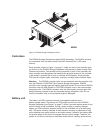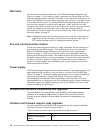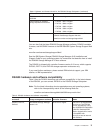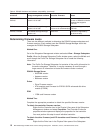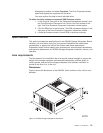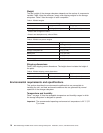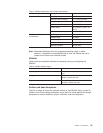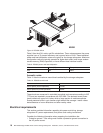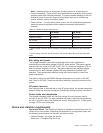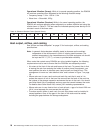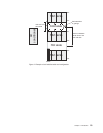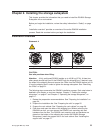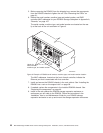
Note: Protective ground is also known as safety ground or chassis ground.
v Circuit overloading – Power circuits and associated circuit breakers must provide
sufficient power and overload protection. To prevent possible damage to the unit,
isolate its power source from large switching loads (such as air conditioning
motors, elevator motors, and factory loads).
v Power failures – If a total power failure occurs, the unit automatically performs a
power-up recovery sequence without operator intervention after power is
restored.
Table 11. DS4500 AC power requirements
Low Range High Range
Nominal Voltage 90 to 136 VAC 198 to 257 VAC
Frequency (Hertz) 50 to 60 Hz 50 to 60 Hz
Idle Current 2 A
a
1 A
b
Maximum Operating Current 2 A
a
1 A
b
Maximum Surge Current 3 A
a
2 A
b
a.
Typical voltage: 120 VAC, 60 Hz, assumes 70% power-supply efficiency and 0.99 power
factor
b.
Typical voltage: 240 VAC, 60 Hz, assumes 70% power-supply efficiency and 0.99 power
factor
Site wiring and power
The storage subsystem uses wide-ranging redundant power supplies that
automatically accommodate voltages to the AC power source. The power supplies
operate within the range of 90 VAC to 257 VAC, at a minimum frequency of 50 Hz
and a maximum frequency of 60 Hz. The power supplies meet standard voltage
requirements for both domestic (inside USA) and international (outside USA)
operation. They use standard industrial wiring with line-to-neutral or line-to-line
power connections.
The agency ratings for the DS4500 Storage Subsystem are 2 amps at 100 VAC
and 1 amp at 240 VAC. These are the overall maximum operating currents for this
system.
AC power recovery
After normal power is restored after a total AC power failure, the storage subsystem
performs power-up recovery procedures automatically without operator intervention.
Power cords and receptacles
The storage subsystem ships with two high-voltage line cord jumpers used to
connect to the rack PDU. You must purchase the power cords that are appropriate
for use in a typical outlet in the destination country. See Appendix C, “Power cords,”
on page 175 for more information.
Shock and vibration requirements
Operational Shock: The DS4500 will be able to withstand a free-fall drop from 0.5
inches onto a hard surface. Subjecting the equipment to a single shock pulse with
the following characteristics will simulate this level of shock:
v Velocity change = 20 inches per second
v Wave form = Triangular,25g @4.00 ms
Chapter 1. Introduction 17



